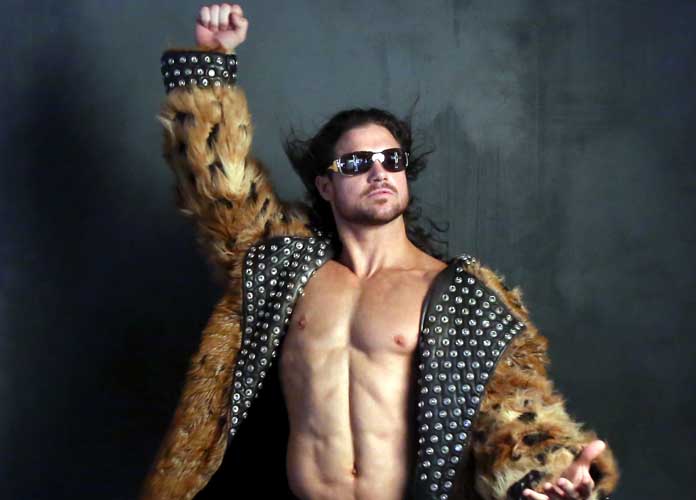James Willems & Johnny Mundo Of ‘Haus Of Pain’ Discuss Their In-Ring Personas & Favorite Wrestling Moves
James Willems & Johnny Mundo on Professional… by Uinterview
It was always James Willems‘ life-long dream to wrestle professionally. He was an incessant viewer of the sport as a kid and even built a ring in his backyard where he and his friends would practice their favorite moves. But when he grew older, he set his dream aside. Now, Willems revisits his first love and learns to become a professional wrestler – even if only for a week – in the new Rooster Teeth documentary Haus of Pain.
Willems and wrestler Johnny Mundo, who helped train Willems for the movie, spoke with uInterview about common misconceptions about professional wrestling, their in-ring personas, and their favorite moves. You can watch their thoughts on the film and working together here.
Having only viewed the sport as a spectator, Willems had several misconceptions about wrestling before he spent a week training for his first and only professional match – albeit, he was always a huge fan of the sport and doesn’t share many of the misconceptions held by non-wrestling fans.
“I think the biggest misconception is that [wrestling is] this hard, tough-guy thing. It has plenty of tough guys but my experience, as difficult as it was, wasn’t necessarily about [that],” Willems told uInterview exclusively. “It was a lot of dudes who also love wresting. Once you have someone there who has a shared common bond of loving wresting, you already have something to talk about. It’s more like family.”
Willems continued, “I thought it was going to be a lot meaner, darker, and harder than it was. But it was actually just a lot of supportive people that want to see you be the best wrestler that you can be.”
One of Willems’ biggest supporters was Mundo, who has had a long professional career, wrestling for nearly a decade in the WWE. He now wrestles in the Lucha Underground and Lucha Libre AAA Worldwide.
Mundo believes people often mistake today’s professional wrestling as an un-athletic and ungraceful sport without much thought put into it.
“I think that when people think wrestling, they are stuck on ’80s, the land of the giants,” Mundo said. “Big dudes that are doing things that don’t seem exceptionally athletic. Impressive? Yes, because of their size back then, but now, it’s really elevated.”
“Wrestling is faster-paced, it’s still hard hitting, but it’s more acrobatic and the possibilities have just grown … It’s become more of a complicated art form.”
One of the things non-wrestling fans may also miss is the amount of thought and effort wrestlers put into creating their characters.
In Haus of Pain, Willems creates a persona named James Angel, an insufferable nice guy who wants everyone to understand how nice he is. The character, Willems admits, came from a place inside him.
“One of the great things that Johnny brought to our training was about how to amplify yourself. The best character you’re going to find, the best character you’re going to portray is an amplified version of yourself,” Willems explained. “Everyone has sort of an egotism to themselves, so I said, what if mine was uncontrollable.”
Mundo, on the other hand, has gone through many names but has maintained a common thread throughout his heel characters – for non-wrestling fans, a heel is a villainous wrestler.
“The one common thread with all of those characters is, ‘I think I’m great,'” Mundo said as he slowly got into character. “Johnny Mundo is the Mayor of Slam-town, the Shaman of Sexy, the Guru of Greatness … The seats are all facing the ring because people should be watching me and telling their wives, girlfriends, and daughters about Johnny Mundo!”
You can watch James Angel and Johnny Mundo in Haus of Pain, available on Rooster Teeth – and be sure to tell your wives, girlfriends, and daughters.
James Willems - "I think the biggest misconception is that it's this hard, tough-guy thing. It has plenty of tough guys. But my experience, as difficult as it was, wasn't necessarily about, 'Hey! You think you can do this? I'll prove that you can't!' It wasn't like a boot camp. It wasn't drill sergeants yelling at you. It was a lot of dudes who also love wresting. And once you have someone there who has a shared common bond of loving wresting, you already have something to talk about. It's more like a family. Welcome to the family, you may not know as much as the more experienced people around you and the trainers that you are working with, but we'll get you there. If you want to get there, we'll get you there. So honestly the biggest misconception I had was a positive one because I thought it was going to be a lot meaner, darker, and harder than it was. But it was actually just a lot of supportive people that want to see you be the best wrestler that you can be."
Johnny Mundo - "For me, I think, especially today, the culture surrounding independent wrestling, wrestling has become more of an art form. In the '60s and '70s if you wanted to become a wrestler, you were going to get your ass kicked, for a couple of – I was going to say a couple of months but maybe even a couple of years, while you are getting into the business. Now, I think, people that I meet outside of the business are usually surprised that I have a degree from U.C. Davis in film and a minor in geology. The amount of thought that goes into a match, the idea that you're just not out there having a street fight. I could compare a wrestling match to a 'save the cat' three act structure. I put everything now in terms of matches. Whenever I'm watching a movie or reading a book, or even a basketball game, like, 'That was the Heat's spot, oh, the comeback, the false finishes and then the finish.' That's how I understand the world. But I think that when people think wrestling, they are still stuck on the '80s, the land of the giants – big dudes that are doing things that don't seem exceptionally athletic. Impressive, yes, because of their size back then, but now it's really elevated. Wrestling is faster-paced, it's still hard hitting, but its more acrobatic and the possibilities have just grown. With the growth and all the years of wrestling, it's become more of a complicated art form.
James Willems - "One of the great things that Johnny brought to our training was about how to amplify yourself. The best character you're going to find, the best character you're going to portray is an amplified version of yourself. Not necessarily something that is so far off the mark. So I kind of just tapped into – everyone has sort of an egotism to themselves. So I said, what if mine was uncontrollable, but also mixing in the idea of, you know, I try to be a good person but sometimes a nice guy is insufferable. So I came up with the persona of 'James Angel.' Again, it was me but it was almost as if god had created him to help everyone out. He's a nice guy, which at a certain point is insufferable, but he is also very much in his own head about being the best person he can be and that can only breed someone who thinks that they are better than everyone else. It wasn't so much that he was a heel, he can play both sides of the fence. But growing up, one of my favorite moments with characters was when Kurt Angle first came out with Olympic medals on and expected people to cheer for him because of that actual, genuine achievement but everyone 'booed.' It didn't work for wrestling fans and I love how he went with it and turned it. He was like, 'You should cheer for me, don't you understand how great I am?' That was always one of my favorite turns in all of wrestling and so to do something like that, worked really well for me. The, 'Oh, why don't you think I'm the greatest guy in the world? You should!' So that's kind of where 'James Angel' began."
Johnny Mundo - "For me, I've had a ton of ring names. I was Johnny Blaze for a heartbeat, then Johnny Spade for a heartbeat, then Johnny Nitro for three and a half years, then John Morrison, and now I'm Johnny Mundo. And some of those name changes were – I can't be John Morrison because WWE owns that name, Johnny Nitro reminded Vince McMahon of WCW and he didn't like it so I just switched it to Morrison. And Johnny Mundo – I was going to be Johnny World but I thought 'World' was hard to chant so we changed it to Mundo for Luce Underground. But the cohesiveness of all of those names, kind of like James said, parts of me that you accentuate and turn the volume up. The one common thread with all of those characters is, I think I'm great. Johnny Mundo is the Mayor of Slam-town, the Shaman of Sexy, the Guru of Greatness. All that stuff is because I know how to play the game better than anyone else. The seats are all facing the ring because people should be watching me and telling their friends, wives, girlfriends, and daughters about Johnny Mundo. That's the common thread of all me heel versions of all my characters.
James Willems - "My favorite moves are moves that I've never actually accomplished myself. Off the top of my head, the Steiner Driver, it always blows my mind even though I've done it, not that move but wrestling, I still can't wrap my head around how that works safely. The Canadian Destroyer was another move that just blows my head off. For me the most fun thing I do, I love attempting the 450, but the Eddie Guerrero Frog Splash, it's not difficult, but it just looks so cool. Doing it is a lot of fun, going off the top rope and just going for it is a lot of fun. So that's what I wanted to make sure I tried in this documentary.
RELATED ARTICLES
Get the most-revealing celebrity conversations with the uInterview podcast!









Leave a comment